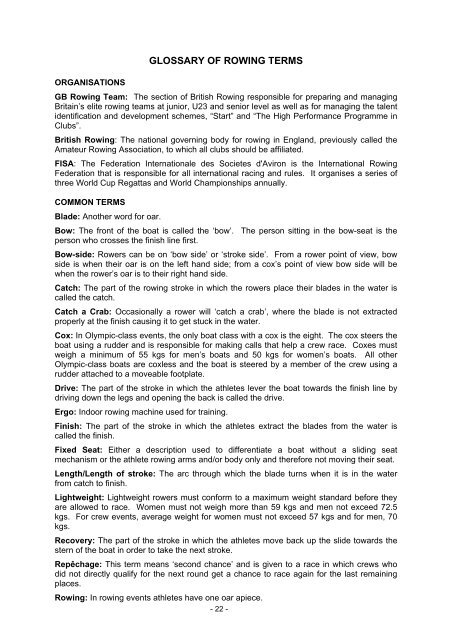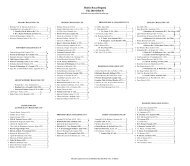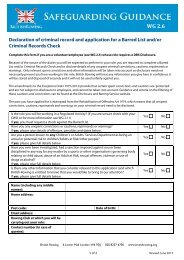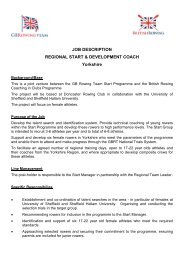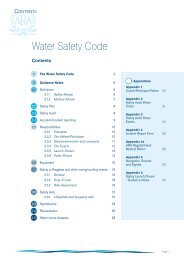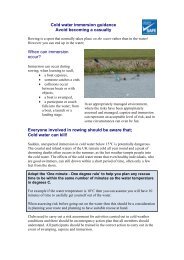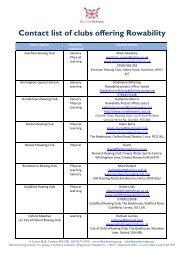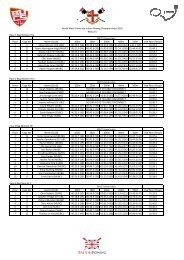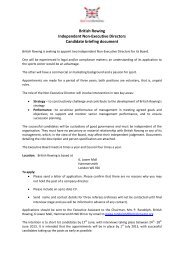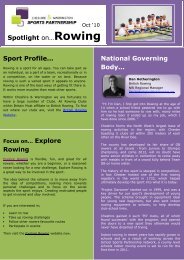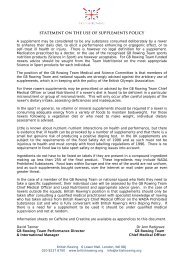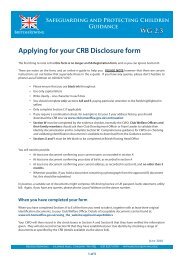2011 World Rowing Championships Press Pack - British Rowing
2011 World Rowing Championships Press Pack - British Rowing
2011 World Rowing Championships Press Pack - British Rowing
Create successful ePaper yourself
Turn your PDF publications into a flip-book with our unique Google optimized e-Paper software.
GLOSSARY OF ROWING TERMS<br />
ORGANISATIONS<br />
GB <strong>Rowing</strong> Team: The section of <strong>British</strong> <strong>Rowing</strong> responsible for preparing and managing<br />
Britain’s elite rowing teams at junior, U23 and senior level as well as for managing the talent<br />
identification and development schemes, “Start” and “The High Performance Programme in<br />
Clubs”.<br />
<strong>British</strong> <strong>Rowing</strong>: The national governing body for rowing in England, previously called the<br />
Amateur <strong>Rowing</strong> Association, to which all clubs should be affiliated.<br />
FISA: The Federation Internationale des Societes d'Aviron is the International <strong>Rowing</strong><br />
Federation that is responsible for all international racing and rules. It organises a series of<br />
three <strong>World</strong> Cup Regattas and <strong>World</strong> <strong>Championships</strong> annually.<br />
COMMON TERMS<br />
Blade: Another word for oar.<br />
Bow: The front of the boat is called the ‘bow’. The person sitting in the bow-seat is the<br />
person who crosses the finish line first.<br />
Bow-side: Rowers can be on ‘bow side’ or ‘stroke side’. From a rower point of view, bow<br />
side is when their oar is on the left hand side; from a cox’s point of view bow side will be<br />
when the rower’s oar is to their right hand side.<br />
Catch: The part of the rowing stroke in which the rowers place their blades in the water is<br />
called the catch.<br />
Catch a Crab: Occasionally a rower will ‘catch a crab’, where the blade is not extracted<br />
properly at the finish causing it to get stuck in the water.<br />
Cox: In Olympic-class events, the only boat class with a cox is the eight. The cox steers the<br />
boat using a rudder and is responsible for making calls that help a crew race. Coxes must<br />
weigh a minimum of 55 kgs for men’s boats and 50 kgs for women’s boats. All other<br />
Olympic-class boats are coxless and the boat is steered by a member of the crew using a<br />
rudder attached to a moveable footplate.<br />
Drive: The part of the stroke in which the athletes lever the boat towards the finish line by<br />
driving down the legs and opening the back is called the drive.<br />
Ergo: Indoor rowing machine used for training.<br />
Finish: The part of the stroke in which the athletes extract the blades from the water is<br />
called the finish.<br />
Fixed Seat: Either a description used to differentiate a boat without a sliding seat<br />
mechanism or the athlete rowing arms and/or body only and therefore not moving their seat.<br />
Length/Length of stroke: The arc through which the blade turns when it is in the water<br />
from catch to finish.<br />
Lightweight: Lightweight rowers must conform to a maximum weight standard before they<br />
are allowed to race. Women must not weigh more than 59 kgs and men not exceed 72.5<br />
kgs. For crew events, average weight for women must not exceed 57 kgs and for men, 70<br />
kgs.<br />
Recovery: The part of the stroke in which the athletes move back up the slide towards the<br />
stern of the boat in order to take the next stroke.<br />
Repêchage: This term means ‘second chance’ and is given to a race in which crews who<br />
did not directly qualify for the next round get a chance to race again for the last remaining<br />
places.<br />
<strong>Rowing</strong>: In rowing events athletes have one oar apiece.<br />
- 22 -


